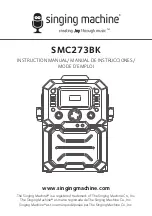
19
E N G L I S H •
User's Manual
· TIGHT CONNECTIONS: Disconnect the Torch
Cables. Disassemble the torch assembly and
inspect all internal components. Replace
any damaged or missing components and
reassemble carefully.
If the steps above do not solve the problem or if
the repair involved are too complex, Please con-
tact a qualified technician.
ARC IGNITES FOR SEVERAL SECONDS BUT
THEN GOES OUT
The air pressure may be too high or too low.
Check the Air Pressure setting on the regulator’s
gauge.
• Air pressure too high: Adjust the Air Regulator
to deliver only 60-80 PSI to the Cutter.
• Air pressure too low:
a. Verify that the compressor is delivering at
least 3.5 CFM @60 PSI to the tool
b. The Regulator on the unit must be set to at
least 60 PSI
• Air pressure correct: Check that the ground-
ing point and the metal being cut are clean, dry,
and free from all coatings and paint. These sec-
tions need to be able to conduct electricity ef-
ficiently.
· DIRTY OR COATED METAL: Use a wire wheel
brush or sander (not included) to thorough-
ly clean both the grounding point and the
area that will be cut. If any cleaners are
used, allow them to dry thoroughly before.
· METAL IS CLEAN IN BOTH AREAS: Make sure
that all air and electrical connections are
tight
> LOOSE CONNECTIONS: Shut off switch, if
not off already, and tighten connections.
If connections do not tighten properly,
contact a qualified technician.
> TIGHT CONNECTIONS:
a. Make certain that you don’t lose work
piece contact after an arc is struck.
b. Make sure that the Torch can function
correctly. Disconnect the Torch Cables.
Disassemble the torch assembly and
inspect all internal components. Re-
place any damaged or missing com-
ponents and reassemble carefully. DO
NOT OVERTIGHTEN.
c. Nozzle is moving too slowly across the
metal and cutting the material from
underneath, breaking contact.
CUT GOES ONLY PARTIALLY THROUGH THE
WORKPIECE
Material being cut is too thick. Maximum thick-
ness for steel is 1/2”.
• MATERIAL TOO THICK: You may wish to cut
the object along one side and then cut along
the other. If this is not practical, use a more
powerful Cutter.
• Within thickness range: Turn up the current
adjustment knob and try again.
· PROBLEM CORRECTED: You may wish to
take note of the setting required for this
metal thickness.
· PROBLEM PERSISTS AT MAXIMUM SETTING:
The Air pressure may be too low. Check
the Air Pressure setting on the regulator’s
gauge.
> AIR PRESSURE TOO LOW:
a. Verify that the compressor is deliver-
ing at least 3.5 CFM @80 PSI to the
tool.
b. The Regulator on the unit must be set
to at least 60 PSI.
> AIR PRESSURE CORRECT: Disassemble the
torch assembly and inspect all internal
components.
- TORCH IN GOOD CONDITION: Try cut-
ting at a slower pace, the arc may not
have enough time to cut through the
work piece.
- DAMAGED COMPONENTS FOUND: Re-
place any damaged or missing compo-
nents and reassemble carefully.
FAST NOZZLE WEAR OR EXCESSIVE SLAG
FORMATION
These two problems have similar causes and
will often appear simultaneously. The same
diagnostic procedures and remedies apply to
both.
The Amperage setting may be too high; try cut-
ting at a lowest setting possible for the metal
being cut.
• Problems reduced: Take into account the thick-
ness and type of metal to be cut before you
start. Thinner materials will typically require
lower amp settings.
• Problems persist at lowest practical setting:
Disconnect the Torch Cables. Disassemble the
torch assembly and inspect all internal compo-
nents.
· TORCH IN GOOD CONDITION: Air supply pres-
sure may be inadequate:
a. Verify that the compressor is delivering at
least 3.5 CFM @ 80 PSI to the tool.
b. The Regulator on the unit must be set to at
least 60 PSI
· DAMAGED COMPONENTS FOUND: Replace
any damaged or missing components and
reassemble carefully.
Содержание CP1040-BV
Страница 21: ...21 Manual de usuario User s manual Notas Notes...
Страница 22: ...22 Notas Notes...
Страница 23: ...23 Manual de usuario User s manual Notas Notes...






































